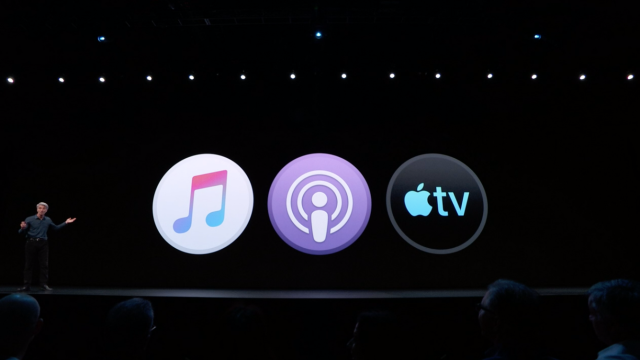With Apple Music, Apple TV+ (and other streaming services) making owning gigabytes of MP3 and video files a thing of the past, iTunes, the iOS desktop companion app that’s been around since the iPod first debuted, is finally dead. In its place are a collection of purpose-built apps that might make the next version of macOS—Catalina—worth the upgrade. iTunes, you probably won’t be missed.
[referenced url=”https://gizmodo.com.au/2019/06/everything-apple-announced-in-its-wwdc-2019-keynote/” thumb=”https://gizmodo.com.au/wp-content/uploads/2019/06/wwdc-2019-410×231.jpg” title=”Everything Apple Announced In Its WWDC 2019 Keynote” excerpt=”Apple’s World Wide Developers Conference has kicked off for another year! We’re suckers for 3am punishment, so we’ll be bringing you everything that was announced live as it happens.”]
RIP iTunes
It was tolerated in the iPod days when the tiny music player in your pocket wasn’t connected to the internet, but iTunes has long been the biggest downside of owning an iPhone or iPad, which allow users to buy apps and stream music and movies right on the device themselves. As a result, iTunes now feels like a bloated part of the iOS ecosystem that’s no longer needed, and Apple finally agrees. macOS 10.15 will see iTunes split into several purpose-specific apps, including Apple TV, Apple Podcasts, and Apple Music, the latter being where you’ll still be able to sync media to an iPhone, and back up your iOS devices.
When it comes to syncing an iOS device, for when migrating to an upgraded device, or restoring an iPhone that feels bloated and sluggish, the Finder in macOS Catalina now handles device backups, so you don’t even have to open the Apple Music app and further clutter your desktop.
Sidecar
Once exclusively available through third-party apps, macOS Catalina is gaining a new feature called Sidecar that allows a tethered or wirelessly connected iPad to serve as a second screen for MacBooks and Macs. But it goes one step further, allowing the connected tablet to be used as a drawing tablet or input device for macOS.
Voice Control
macOS Catalina will also feature much improved voice control functionality for those with motor limitations, allowing nearly every aspect of the operating system, from writing text, to controlling media playback, to be operated without a mouse or keyboard—just voice commands which are all processed and interpreted on the local machine so there’s no security or privacy issues.
Find My
Tracking a lost smartphone or tablet is easier when it’s perpetually connected to a mobile phone network, but much harder on a MacBook when it’s only periodically connected to a limited range wi-fi network. With macOS Catalina’s new Find Me, stolen or missing Mac computers that are offline can send out an encrypted and anonymous Bluetooth beacon that other nearby Macs can detect and help pinpoint its location. It’s not perfect, but it’s a definite improvement to not only recovering stolen hardware, but also deterring theft in the first place.
To further help protect your hardware, Macs that include Apple’s T2 security chip will also include an Activation Lock feature that works similar to how it does on iOS devices, preventing the computer from booting without the user’s authorised credentials.
Project Catalyst
Ahead of last year’s WWDC rumours were flying that Apple was finally going to merge Mac OS and iOS into a single operating system that brought the best of both worlds to desktop and mobile devices. Not only did that not happen, but Apple also insisted it never would. As a consolation prize, Apple introduced a new universal framework, code-named Marzipan, that made it easy for UIKit developers (iOS and tvOS) to port their apps to Apple’s desktop computers. That initiative is now known as Project Catalyst, and with macOS Catalina Apple is expanding the availability of Marzipan to all third-party UIKit developers who will only have to maintain a single codebase to create apps that work on iPhones, iPads, and Macs.
Screen Time will now shame your laptop procrastination too
If you cringe every time your iPhone or iPad reveals just how much time you’ve been spending on social media, your iMac and MacBook will soon do the same, shaming you for all the time you spend on YouTube, Facebook, Twitter, instead of being productive on Mac OS apps like Numbers and Pages.
macOS Catalina is available to developers starting today, with a public beta arriving in July. But if you’re not into living life on the wild side (and potentially losing a lot of unsaved work to a crash) you’ll have to wait until the Fall for the OS update to officially be released.
